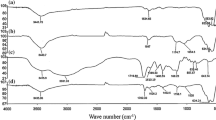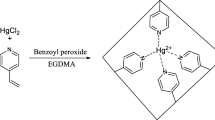Abstract
An ion-imprinted polymer (IIP) was obtained by copolymerization of methacrylic acid (as a functional monomer) and ethylene glycol dimethacrylate (as a crosslinking agent) in the presence of various chelators for Pt(II) ion and using 2,2′-azo-bis-isobutyronitrile as the initiator. Specifically, acetaldehyde thiosemicarbazone (AcTSn) and benzaldehyde thiosemicarbazone (BnTSn) were used as chelators. The IIPs were applied as sorbents for solid-phase extraction of Pt(II) and Pt(IV) ions from aqueous solutions. The effects of acidity and flow rate of the sample, of elution conditions and of potentially interfering ions were investigated. The imprinting effect of analyte is clearly demonstrated by the fact that only the IIP is capable of quantitative retention of Pt(II) and Pt(IV) ions. The method works best in the pH range from 0.5 to 1 and from 3.5 to 9.5. The ions can be recovered with an acidic solution of thiourea. The Pt-AcTSn polymer displays better sorption properties for the separation of analytes. The selectivity coefficients of the Pt-AcTSn and control polymers for Pt(IV) in the presence Pd(II), Rh(III), Ru(III), Al(III) and Cu(II) were calculated, and the sorbent capacity for Pt(IV) was found to be 4.56 μg g -1. The method was successfully applied to the determination of Pt(IV) by electrothermal atomic absorption spectrometry in tap water, tunnel dust and anode slime samples.

The new ion imprinted polymers based on Pt(II)-thiosemicarbazone derivative chelates were prepared and used as solid phase extraction sorbent for selective separation of platinum. The method was successfully applied to the determination of analyte in environmental samples by electrothermal atomic absorption spectrometry


Similar content being viewed by others
References
Zereini F, Alt F (eds) (2000) Anthropogenic platinum group element emission. Springer, Berlin
Prichard HM, Sampson J, Jackson M (2009) A further discussion of the factors controlling the distribution of Pt, Pd, Rh and Au in road dust, gullies, road sweeper and gully flusher sediment in the city of Sheffield, UK. Sci Tot Environ 407:1715–1725
Hooda PS, Miller A, Edwards AC (2007) The distribution of automobile catalysts-cast platinum, palladium and rhodium in soil adjacent to roads and their uptake by grass. Sci Tot Environ 384:384–392
Bencs L, Ravindra K, Grieken RV (2003) Methods for the determination of platinum group elements originating from the abrasion of automotive catalytic converters. Spectrochim Acta Part B 58:1723–1755
Chwastowska J, Skwara W, Sterlińska E, Pszonicki L (2004) Determination of platinum and palladium in environmental samples by graphite furnace atomic absorption spectrometry after separation on dithizone sorbent. Talanta 64:224–229
Brzezicka M, Baranowska I (2001) Methods for separation of trace amounts of platinum and investigation of the influence of interfering elements during platinum determination in copper ores and copper concentrates by graphite furnace atomic absorption spectrometry. Spectrochim Acta Part B 56:2513–2520
Cantarero A, Gomez MM, Camara C, Palacios MA (1994) On-line preconcentration and determination of trace platinum by flow –injection atomic absorption spectrometry. Anal Chim Acta 296:205–211
Godlewska-Żyłkiewicz B, Leśniewska B, Gąsiewska U, Hulanicki A (2000) Ion-exchange preconcentration and separation of trace amounts of platinum and palladium. Anal Lett 33:2805–2820
Godlewska-Żyłkiewicz B, Leśniewska B, Michałowski J, Hulanicki A (1999) Preconcentration of trace amounts of platinum in water on different sorbents. Intern J Environ Anal Chem 75:71–81
Bosch-Ojeda C, Sanchez Rojas F, Cano Pavon JM, Garcia de Torres A (2003) Automated on-line separation–preconcentration system for platinum determination by electrothermal atomic absorption spektrometry. Anal Chim Acta 494:97–103
Gonzalez-Garcia MM, Sanchez Rojas F, Bosch Ojeda C, Garcia de Torres A, Cano Pavon JM (2003) On-line ion-exchange preconcentration and determination of traces of platinum by electrothermal atomic absorption spectrometry. Anal Bioanal Chem 375:1229–1233
Kovacheva P, Djingova R (2002) Ion-exchange method for separation and concentration of platinum and palladium for analysis of environmental samples by inductively coupled plasma atomic emission spectrometry. Anal Chim Acta 464:7–13
Vlasankova R, Otruba V, Bendl J, Fisera M, Kanicky V (1999) Preconcentration of platinum group metals on modified silicagel and their determination by inductively coupled plasma atomic emission spectrometry and inductively coupled plasma mass spectrometry in airborne particulates. Talanta 48:839–846
Muller M, Heumann KG (2000) Isotope dilution inductively coupled plasma quadrupole mass spectrometry in connection with a chromatographic separation for ultra trace determinations of platinum group elements (Pt, Pd, Ru, Ir) in environmental samples. Fresenius J Anal Chem 368:109–115
Godlewska-Żyłkiewicz B (2004) Preconcentration and separation procedures for the spectrochemical determination of platinum and palladium. Microchim Acta 147:189–210
Myasoedova GV, Mokhodoeva OB, Kubrakova IV (2007) Trends in sorption preconcentration combined with noble metal determination. Anal Sci 23:1031–1039
Prasada Rao T, Daniel S (2003) Preconcentration of trace and ultratrace amounts of platinum and palladium from real samples. Rev Anal Chem 22:167–190
Doker S, Malci S, Dogan M, Salih B (2005) New poly(N-(hydroxymethyl)methacrylamide–1-allyl-2-thiourea) hydrogels prepared by radiation-induced polymerisation: selective adsorption, recovery and pre-concentration of Pt(II) and Pd(II). Anal Chim Acta 553:73–82
Neagu V, Paduraru C, Bunia I, Tofan L (2009) Platinum(IV) recovery from chloride solution by functionalized acrylic copolymers. J Environ Manag 91:270–276
Daniel S, Gladis JM, Prasada Rao T (2003) Synthesis of imprinted polymer material with palladium ion nanopores and its analytical application. Anal Chim Acta 488:173–182
Daniel S, Praveen RS, Prasada Rao T (2006) Ternary ion-association complex based ion imprinted polymers (IIPs) for trace determination of palladium(II) in environmental samples. Anal Chim Acta 570:79–87
Daniel S, Babu PEJ, Prasada Rao T (2005) Preconcentrative separation of palladium(II) using palladium(II) ion-imprinted polymer particles formed with different quinoline derivatives and evaluation of binding parameters based on adsorption isotherm models. Talanta 65:441–452
Prasada Rao T, Daniel S, Gladis JM (2004) Tailored materials for preconcentration or separation of metals by ion-imprinted polymers for solid-phase extraction (IIP-SPE). Trends Anal Chem 23:28–35
Godlewska-Żyłkiewicz B, Leśniewska B, Wawreniuk I (2010) Assessment of ion imprinted polymers based on Pd(II) chelate complexes for preconcentration and FAAS determination of palladium. Talanta 83:596–604
Zambrzycka E, Roszko D, Leśniewska B, Wilczewska AZ, Godlewska-Żyłkiewicz B (2011) Studies of ion-imprinted polymers for solid-phase extraction of ruthenium from environmental samples before its determination by electrothermal atomic absorption spectrometry. Specrochimica Acta Part B 66:508–516
Hoai NT, Yoo DK, Kim D (2010) Bach and column separation characteristics of copper-imprinted porous polymer micro-beads synthesized by a direct imprinting method. J Hazard Mater 173:462–467
Saraji M, Yousefi H (2009) Selective solid-phase extraction of Ni(II) by an ion-imprinted polymer from water samples. J Hazard Mater 167:1152–1157
Konstantinović SS, Radovanović BC, Todorović ZB, Ilić SB, Konstantinović BV (2007) Spectroscopic and thermodynamic studies of complexation of some divalent metal ions with istatin-β-thiosemicarbazone. Chem Pap 61:485–489
Agrawal RK, Prasad S (2005) Synthesis and spectral investigations of some platinum metals ions coordination compounds of 4[N-(furan-2′-carboxalidene)amino]antipyrine thiosemocarbazone and 4[N-(3′,4′,5′-trimethoxybenzalidene)amino]antipyrine thiosemocarbazone. Turk J Chem 29:289–297
Pal I, Basuli F, Bhattacharya S (2002) Thiosemicarbazone complexes of platinum metals. A story of variable coordination modes. Proc Indian Acad Sci 114:255–268
Shah R, Devi S (1997) Preconcentration and separation of palladium(II) and platinum(IV) on a dithizone –anchored poly(vinylpyridine)-based chelating resin. Anal Chim Acta 341:217–224
Chen YY, Liang Ch, Chao Y (1998) Synthesis and characterization of polyacrylonitryle-thiosemicarbazide resin and its sorption behavior for Rh(III), Ru(III), Pd(II) and Ir(IV) ions. React Funct Polym 36:51–58
Godlewska-Żyłkiewicz B, Malejko J, Leśniewska B, Kojło A (2008) Assessment of immobilized yeast for the separation and determination of platinum in environmental samples by flow-injection chemiluminescence and electrothermal atomic absorption spectrometry. Microchim Acta 163:327–334
Cosden J, Schijf J, Byrne RH (2003) Fractionation of platinum group elements in aqueous systems: comparative kinetics of palladium and platinum removal from seawater by Ulva lactuca L. Environ Sci Technol 37:555–560
Kononova ON, Leyman TA, Melnikov AM, Kashirin DM, Tselukovskaya MM (2010) Ion exchange recovery of platinum from chloride solutions. Hydrometallurgy 100:161–167
Nischwitz V, Michalke B, Kettrup A (2003) Speciation of Pt(II) and Pt(IV) in spiked extracts from road dust using on-line liquid chromatography-inductively coupled plasma mass spectrometry. J Chromatogr A 1016:223–234
Acknowledgements
The authors gratefully acknowledge the financial support of the Polish Ministry of Science and Higher Education (project N N 204 246 135).
Author information
Authors and Affiliations
Corresponding author
Rights and permissions
About this article
Cite this article
Leśniewska, B., Kosińska, M., Godlewska-Żyłkiewicz, B. et al. Selective solid phase extraction of platinum on an ion imprinted polymers for its electrothermal atomic absorption spectrometric determination in environmental samples. Microchim Acta 175, 273–282 (2011). https://doi.org/10.1007/s00604-011-0685-1
Received:
Accepted:
Published:
Issue Date:
DOI: https://doi.org/10.1007/s00604-011-0685-1




